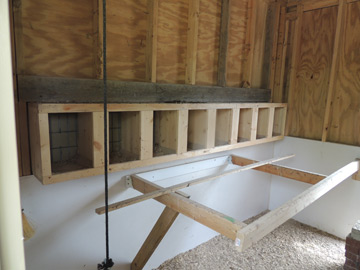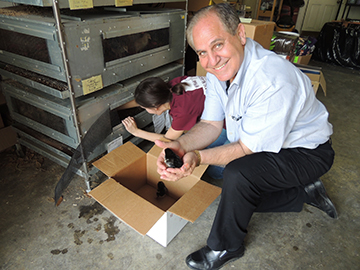Welcome to “Coop de Ville”….ain’t nobody here but us chickens!
Why did the chicken cross the road? To get to White Oak Farm’s “Coop de Ville” condo. The henhouse has an interior, dual staircase and laying cubicles, which are created at a comfortable slope so that the fresh eggs gently glide to the exterior portals for easy egg gathering. Atop “Coop de Ville” is our exquisite New England-style rooster cupola. Cock-a-doodle! There are no better living quarters in the South for these heirloom breeds.
Heirloom breeds must meet certain standards set by the American Poultry Association. These breeds must have been established before the mid-20th century with lineages that can be traced back through multiple generations. Natural mating is a requirement of both the parents and grandparents, and heirlooms must have been sired by an APA standard breed. Heirloom breeds are defined by a long lifespan. For breeding hens that means having from 5 to 7 productive egg-laying years. (Roosters’ are only expected to have 3 to 5 productive years.) It is also important that heirloom breeds have a slow growth rate, giving the chicken time to develop strong skeletal structure and healthy organs before building muscle mass. It should take at least 14 weeks for the breed to reach market weight.
 The Buff Orpington breed, named for Orpington, England, was bred to be an excellent egg layer with quality meat. These voluptuous, gently contoured chicks have a rich, golden color with a soft appearance. Combined with the fluff of their feathers, these gorgeous birds have become more popular show birds than a utility breed. This chicken has a sweet disposition with wonderful mothering (or brooding) instincts. Though these backyard birds do well in cold climates, they seem to be at home in the balmy South, as long as their feathers don’t get wet. (Their feathers are definitely not waterproof!) The Buff Orpington breed, named for Orpington, England, was bred to be an excellent egg layer with quality meat. These voluptuous, gently contoured chicks have a rich, golden color with a soft appearance. Combined with the fluff of their feathers, these gorgeous birds have become more popular show birds than a utility breed. This chicken has a sweet disposition with wonderful mothering (or brooding) instincts. Though these backyard birds do well in cold climates, they seem to be at home in the balmy South, as long as their feathers don’t get wet. (Their feathers are definitely not waterproof!)
 The Black Australorp originated in Australia, though the original stock was imported from the Black Orpington hen yards of William Cook and Joseph Partington in England between 1890 and the early 1900s. In Australia, the Black Orpington stock was crossbred with Minorca, White Leghorn and Langshan breeds to improve upon its utility features. Australorps have soft, shiny black feathers that reflect a lustrous green sheen that breeders call “beetle green.” Along with black legs and beak, a somewhat large, upright comb with five distinct points, and white toenails, this bird is a real “looker.” These hardy, docile “beetle green egg-laying machines” produce about 250 light-brown eggs annually. And, Australorps are a “dual purpose” breed; they produce great eggs and great meat. The egg laying record was set by an Australorp that laid 364 eggs in 365 days. The Black Australorp originated in Australia, though the original stock was imported from the Black Orpington hen yards of William Cook and Joseph Partington in England between 1890 and the early 1900s. In Australia, the Black Orpington stock was crossbred with Minorca, White Leghorn and Langshan breeds to improve upon its utility features. Australorps have soft, shiny black feathers that reflect a lustrous green sheen that breeders call “beetle green.” Along with black legs and beak, a somewhat large, upright comb with five distinct points, and white toenails, this bird is a real “looker.” These hardy, docile “beetle green egg-laying machines” produce about 250 light-brown eggs annually. And, Australorps are a “dual purpose” breed; they produce great eggs and great meat. The egg laying record was set by an Australorp that laid 364 eggs in 365 days.
 The Buckeyes have the distinction of being the only breed created by a woman. In the late 19th century, Nettie Metcalf bred these birds in Ohio, naming them for the “buckeye state.” These mahogany-colored birds have shiny black tail feathers and a small “pea” comb. Not only do Buckeyes have a descent egg laying ability (producing about 200 eggs a year), but they have strong meat producing characteristics as well. Buckeyes are yellow skinned chickens that lay brown eggs. As of 2008, Buckeyes were recognized as a critically endangered breed. The Buckeyes have the distinction of being the only breed created by a woman. In the late 19th century, Nettie Metcalf bred these birds in Ohio, naming them for the “buckeye state.” These mahogany-colored birds have shiny black tail feathers and a small “pea” comb. Not only do Buckeyes have a descent egg laying ability (producing about 200 eggs a year), but they have strong meat producing characteristics as well. Buckeyes are yellow skinned chickens that lay brown eggs. As of 2008, Buckeyes were recognized as a critically endangered breed.
Take a look around. Here's our progress, from start to finish!
Click here to see our chicks in action!








.jpg)


.jpg)


|

